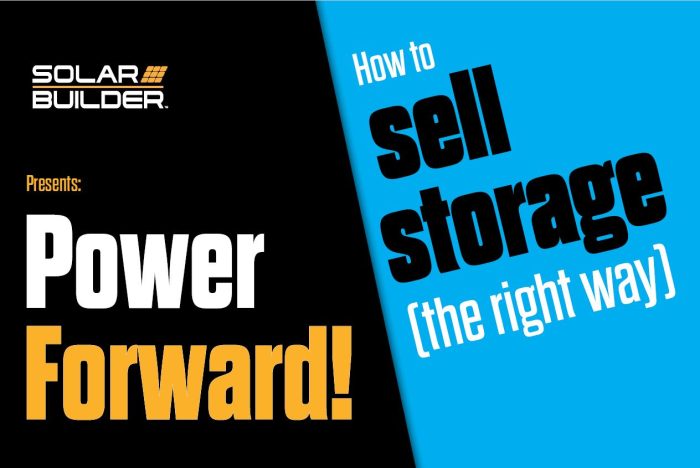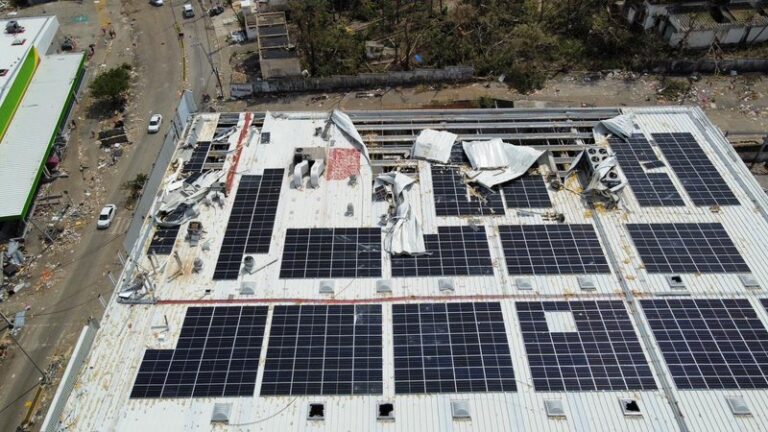Seven months after Hurricane Otis devastated the resort town of Acapulco on Mexico’s Pacific coast, this Category 5 hurricane offered lessons for locals and businesses. The metal roof solar project at Grupo Comercial Chedraui, a supermarket chain, suffered serious damage. However, the Acapulco store’s metal solar roof (293 kWp) was one of the few to survive the onslaught of wind and rain, attributed to the clamp mounting that secured the solar panels to the roof. the roof and the entire infrastructure.
Just a month before Hurricane Otis made landfall, solar EPC Energía Real completed the solar PV installation on the store’s KR-18 sheet steel roof, including:
The Hurricane | On October 25, 2023, Hurricane Otis has made landfall near the port of Acapulco with maximum sustained winds of about 170 miles per hour. The intensity Otis acquired surprised climate scientists. The data from the surveillance systems did not anticipate the risk of a destructive force that would cause the disaster in Acapulco and nearby cities, causing human and material losses.

The destruction | While most surrounding stores, restaurants, hotels and businesses suffered significant damage from the Category 5 hurricane, the Chedraui store remarkably remained largely intact. In the aftermath of the hurricane, the roofer visited the site to inspect for roof damage. Parts of the roof without solar energy suffered from roof blow-off. However, the solar panels on the store’s roof, secured by the PVKITs and MX Mini clamps, survived the destruction.
Metal roofing in strong winds
Metal roofing, particularly standing seam metal roofing, is known for its exceptional performance in high winds, due in part to its fastening methods and interlocking installation where roof panels overlap and are secured to the building structure, increasing the ability of roof covering is reduced. wind to disturb the panels. Metal roofing lends itself to high wind areas because it can easily be designed to withstand virtually any uplift force at the design stage.
Photos of the site taken after the hurricane clearly indicate that the vast majority of roof damage occurred on areas of the roof where solar was not installed.

This is clearly visible even in the edge roof areas with higher pressure, where the roof panels along the edge areas, under the solar panels, were not damaged while the nearby bare roof covering was blown away. The logical conclusion is that the solar panels, PVKITs and MX Mini clamps installed over parts of the roof prevented those parts from breaking, thereby preserving both the solar panels and the roof.
The MX Mini clamps together with the PVKIT solar mountings from S-5! were installed to secure the solar panels to the metal roof, but the clamps served a secondary function as wind clamps, often called external seam clamps. These external seam clips measurably increase the roof’s resistance to wind uplift, preventing multiple types of failure, including seam separation and clip loosening (when used in roof clip locations).
Third-party testing conducted in 2013 resulted in a 300% increase in the uplift resistance of a metal roof when S-5!’s WindClamps were installed at the roof seams. The MX Mini clamps on the roof of the Chedraui supermarket acted as external seam clamps during the Category 5 hurricane in Acapulco.
When you consider how the wind creates upward forces as it approaches and blows over the solar panels installed on the roof, the dynamics of the wind forces shifted from direct pressure on the roof to shared pressure on both the roof and the solar panels. The metal roof seams were strengthened by the installation of the clamps to withstand the upward pressure on the roof and met the challenge of securing the solar panels to the building, preventing the upward forces of the wind from removing them from the building would tear and retain the roof.
In this scenario, these upward forces were transferred to the KR-18 roof via the PVKITs and MX Mini clamps, and then from the roof panels to the roof clips and to the building structure. Together, these components and connections were strong enough to prevent the modules from detaching from the roof panels and the roof from pulling away from the building structure.
Often the concern is that a metal roof panel, such as the KR-18, is not strong enough to transmit the forces as part of the load path described above, or that the roof clips may become overloaded and fail by these individual point loads. . Observations in this case study show that such concerns are unfounded. All components in the loading path and all connections between components remained intact and connected, keeping the system together and undamaged, including the roof panels and roof clips. The roof under the solar panels was clearly not damaged or torn off.
Listen to more in-depth conversations on Solar Builder’s YouTube channel

Our most popular series include:
Power forward! | A collaboration with BayWa re to discuss industrial topics at a higher level.
The buzz | Where we give our 2 cents per kWh in the residential solar market.
The pitch | Discussions with solar manufacturers about their new technology and ideas.
Source link


